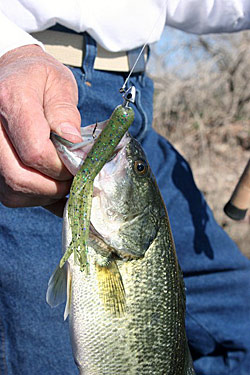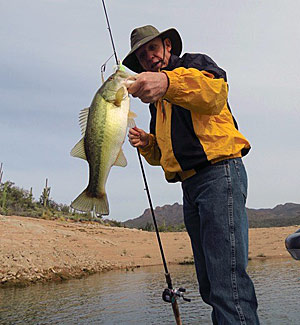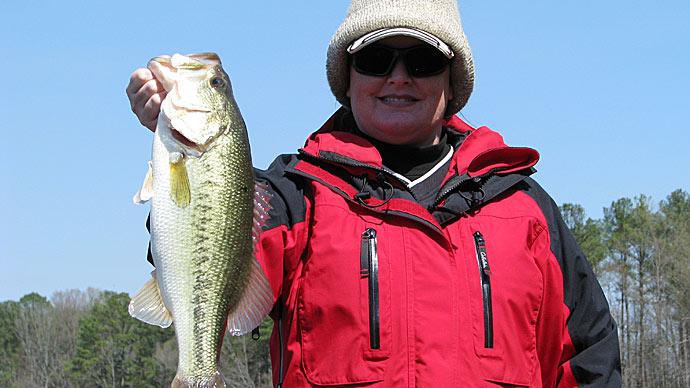
It may not be so where you fish, but out West on our 200-foot deep reservoirs, the common wisdom is that you have to fish deep in winter. But what if the entire lake or river is shallow? Our urban lakes have bass, and the deepest they can go is about five feet. Fish don’t hibernate; even in bottomless lakes, the bass are often shallow, even in the dead of winter.
Gary Dobyns, one of the all-time greatest western bass fishermen of all time, told me once that he starts out fishing shallow no matter what time of year it is. “I don’t know the best way to start fishing in winter, but I can tell you how I start regardless of weather, water temperature, or location. I start shallow.” Gary believes there are always shallow bass no matter how cold or the conditions.
Although many guys go shallow later in the day, Gary likes to go to the bank first – it’s his most productive time. He has found that fish will go to the back of a creek and put their head in the current, just waiting for it to bring them something to eat. He’ll also target bridge pilings and mud banks. When the bite is tough, Gary likes tubes and fishes them in various ways. You can flip them or finesse them on light line, he says, but he also has great success just rigging them on a dart head and throwing them to shore -- reeling them back like a crankbait. Now and again, he’ll give the rod tip a little bounce. If the bass are more aggressive, a Yamamoto grub is also ideal for this technique.
Flipping is a proven technique for shallow bass, and contrary to popular myth, it isn’t necessarily a slow way to fish. You can flip a jig and pig into a shallow cover or next to a stump, shake it several times, and move on. One of the best flippers I ever met was Jerry Suk, who used to fish the AllStar Bass circuit in Arizona. This guy had the touch – he’d take a Yamamoto smoke/sparkle grub and flip with it all year long. Some fish would come up and slam it the instant it hit the water.
Suk never pegged his sinkers because he said the line jumped slightly without a peg. He was a total line watcher – the lure would stop sinking, then there would be a bit of pressure, and he’d slam the hookset home. He used a 7-1/2 foot flipping stick and Owner hooks, which he touched up frequently to keep them razor sharp.

Jerry would flip to any structure – rocks, trees, stumps, pilings, docks – you name it. He said that one big mistake people make is leaving fish too soon – when he’d catch a fish, he’d flip around the same spot in case there was a concentration of bass there, which happened frequently enough to keep him doing it all the time. Often, even if the water the trees were in was over twenty feet deep, he’d catch the bass six feet down, just hanging out in the branches. He usually fished the shady side of the branches. One tip for fishing in trees is to keep pulling when you set the hook. Once he gets you wrapped up, you’re lost.
The flipping technique was invented by a California man named Dee Thomas. It’s perfect for reaching through branches of submerged trees or targeting specific areas of shade or cover. You use a long, stiff rod, a very tough line (a lot of guys like braid), and a reel with some power. You let out enough line to reach as far down as you’d like to fish, then while holding the reel in one hand, you use the other hand to grab the line and pull it out to the side so that the lure is hanging just a short way away from the rod tip. Using the long rod, you get the lure over your target, then bring your line hand closer and closer to the reel to allow the lure to drop directly to the target. Suk said you should hit bottom (or the target) just as your hand reaches the reel.
Doodling is a light-line technique developed by my buddy Don Iovino. Iovino is a master at reading electronics and is fantastic at doodling deep fish, but doodling isn’t limited to deep water. A good drop-off with a piece of structure on it is the ideal place to doodle. A drop-off alone isn’t enough, he says – it needs to have some structure – rocks, stumps, trees, logs, whatever. Doodling uses light line and a small bait, usually a plastic worm. The worm is rigged, Texas. The key is to use a brass bullet weight and a glass bead. The bead is between the hook and the sinker.

The doodle rod needs enough backbone to set the hook, but it also needs a limber tip so you can shake the lure. This shaking makes the glass bead and the brass sinker click, which is the key to doodling. The sound and the vibration attract fish. Doodling is shaking, not hopping, but if you want to cover some water with a doodle rig, you can shake the worm as you work it back to the boat. This is an ideal technique for fish holed up in trees – they’ll often come right out after it, especially if you run it past them a couple of times.
A spinnerbait is another effective way to get big bass in winter to bite. An incredible spinnerbait fisherman, Sam Shattenberg, once told me that bass start to school in the fall and often group together by size. He knew that once he found a good fish, he was likely to find more. Sam would start on flats during the winter with a good drop-off because that’s where the bass will come up to feed early in the morning, even in winter. He wakes the baits just under the surface, then switches tactics and goes to structure, paying particular attention to little cuts and points going into the coves.
The key to success is often persistence. Cast in every direction and run the spinnerbait back at different angles. You may make 30 fruitless casts and then catch several fish. Another key is the way you fish a spinnerbait. Keep the rod pointed directly at the lure and as horizontal as possible – you’ll feel everything that spinnerbait does. If you hold the rod off to the side or point it at the water, you’re not going to feel as much, and you’re not going to have as much power when you set the hook. The instant you feel those blades stop or sense pressure, you should be slamming the point home while reeling.
Another way to increase your ability to feel the bites is to fish with your finger and thumb loosely on the line in front of the reel. That will help you sense if the blades stop moving or if a big bass inhales your bait.
Bass, even the big ones, are not always deep in winter. Watch for bait fish, and remember that even crawdads don’t hole up until the water temps dip below 40. You may be surprised at how many fish you find on the bank, no matter how cold it is.




